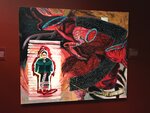

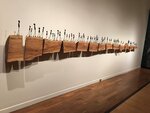
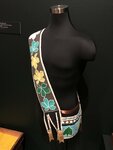
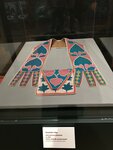
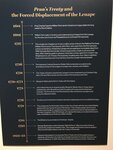
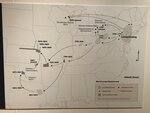

“It’s what I think of as propaganda,” said Lenape artist Joe Baker, standing before paintings of William Penn’s Treaty with the Lenni Lenape.
The paintings by Benjamin West and Edward Hicks are on display at the Michener Museum of Art in Doylestown – in “Never Broken: Visualizing Lenape Histories,” an exhibition featuring the work of Baker and three other Lenape artists that aims to show how art tells stories about history and identity, and how art can be used to tell new stories and correct history.
The images of Penn’s Treaty by European-American artists are what people think of when they think of Lenape history, said Laura Turner Igoe, chief curator at the Michener, but West’s were created almost a century later – in England – and Hicks “appropriated West’s composition for his own paintings of Penn’s Treaty,” and incorporated the scene into his “Peaceable Kingdom” series, according to the Michener.
“All of this speaks to the myth-making of the treaty and the formation of America,” said Baker, a member of the Delaware Tribe of Indians – the name given to the Lenape by the U.S. government. Baker and Igoe, curators of “Never Broken,” running through Jan. 14, recently provided a pre-opening tour of the exhibition, and the four Native American artists took part in a panel discussion.
“Never Broken” is the first exhibition by the museum to focus on indigenous art and the first featuring all Lenape artists, Igoe said. It features recent and newly commissioned works by Baker, co-founder and executive director of Lenape Center in Manhattan; Ahchipaptunhe, of the Delaware Tribe of Indians and Cherokee; Holly Wilson, of the Delaware Tribe of Indians and Cherokee; and Nathan Young, of the Delaware Tribe of Indians, Pawnee and Kiowa.
Their artwork expresses personal and tribal identity and addresses violent displacement of the Lenape from Lenapehoking, the ancestral homeland of the Lenape, which once was spread across areas including eastern Pennsylvania, New Jersey and southeastern New York. This includes the land where the museum sits.
At the time Hicks painted his version of Penn’s Treaty with the Indians at Shackamaxon, Baker said, “…the Lenape had been entirely pushed out of the state of Pennsylvania.”
The four Native American artists grew up largely in Oklahoma, far outside Lenapehoking, the ancestral homeland of the Lenape. The majority of the “Never Broken” exhibition features their work, along with some work by previous generations of Lenape.
Nineteenth century beaded bandolier bags are displayed alongside more current beadwork by Baker, who also shows paintings representing members of his family; large-scale abstract paintings by Ahchipaptunhe echo the geometric forms and shapes on Lenape pottery and stamped designs on Lenape baskets borrowed from the New Jersey State Museum.
Wilson’s “Bloodline,” made of bronze and locust wood is a striking documentation of her family history, created after documenting her family ancestry in order to enroll herself and her children as tribal members. The Big House installation stands as a remembrance of the principal religion of the Lenape.
A video and sound piece by Young examines the events of the Walking Purchase in 1737, in which Penn’s sons defrauded the Lenape out of more than 1 million acres of land in Eastern Pennsylvania.
Tribe members were driven west from Lenapehoking in the 1700s, and still farther west in the 1800s. A scalp bounty in 1756 promised money for the scalps of Lenape men, woman and children. “There’s no other word that accurately describes that reality than genocide,” said Baker.
“That violence followed us all the way to Oklahoma,” Baker said during the panel discussion. “Until we deal with our history and come to terms with the foundation of this country, I don’t think we can truly heal.”
Join our readers whose generous donations are making it possible for you to read our news coverage. Help keep local journalism alive and our community strong. Donate today.